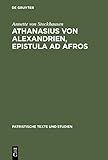Athanasius von Alexandrien, Epistula ad Afros : Einleitung, Kommentar und Übersetzung / Annette von Stockhausen.
Material type: TextSeries: Patristische Texte und Studien ; 56Publisher: Berlin ; Boston : De Gruyter, [2014]Copyright date: ©2002Edition: Reprint 2013Description: 1 online resource (366 p.)Content type:
TextSeries: Patristische Texte und Studien ; 56Publisher: Berlin ; Boston : De Gruyter, [2014]Copyright date: ©2002Edition: Reprint 2013Description: 1 online resource (366 p.)Content type: - 9783110171594
- 9783110866261
- Christian saints -- Egypt -- Alexandria -- Correspondence
- Theology and Religious Studies -- Patristics -- Introductions and Overviews
- Theology and Religious Studies -- Patristics -- Patristic Authors
- Altertum /Religion
- Athanasius (von Alexandrien)
- Athanasius ‹Alexandrinus›: Ad Afros episcopos
- RELIGION / Christian Theology / Ecclesiology
- 270.2092 23
- BR65.A443 .S763 2001
- online - DeGruyter
- Issued also in print.
| Item type | Current library | Call number | URL | Status | Notes | Barcode | |
|---|---|---|---|---|---|---|---|
 eBook
eBook
|
Biblioteca "Angelicum" Pont. Univ. S.Tommaso d'Aquino Nuvola online | online - DeGruyter (Browse shelf(Opens below)) | Online access | Not for loan (Accesso limitato) | Accesso per gli utenti autorizzati / Access for authorized users | (dgr)9783110866261 |
Dissertation Universität Erlangen-Nürnberg 2000.
Frontmatter -- Vorwort -- Inhaltsverzeichnis -- Einführung -- I. Teil. Einleitung -- 1. Die Adressaten -- 2. Die Abfassungszeit -- 3. Die Echtheit -- 4. Die Form und Gattung -- 5. Das Verhältnis zu anderen Schriften des Athanasius -- 6. Die Sprache, der Stil und Formen der Argumentation -- 7. Der Aufbau -- II. Teil. Kommentar -- Der Titel -- Kapitel 1 -- Kapitel 2 -- Exkurs I: Die Nachrichten über die Synode von Rimini -- Kapitel 3,1-3 -- Kapitel 3,4-4,1 -- Kapitel 4,2 - 5,1 -- Kapitel 5,2-6,4 -- Exkurs II: Eine Exegese des Nizänums -- Kapitel 7-8 -- Kapitel 9 -- Kapitel 10-11 -- Literaturverzeichnis -- Register -- Wortregister -- Register der Bibelstellen -- Stellenregister Athanasius -- Stellenregister der übrigen antiken Autoren -- Register der antiken Personen -- Register der Synoden und Synodaldokumente -- Register der modernen Autoren
restricted access online access with authorization star
http://purl.org/coar/access_right/c_16ec
Die Epistula ad Afros, ein Schreiben an die Bischöfe der Diözese Africa, das wahrscheinlich um 366/67 abgefasst wurde, ist ein wichtiges Zeugnis für die theologische Position des Athanasius in der bisher wenig beachteten Zeit nach der Rückkehr aus seinem letzten Exil. In Auseinandersetzung mit der Synodalgeschichte seit Mitte der 50er Jahre des 4. Jahrhunderts stellt er nachdrücklich das Nizänum als einzig orthodoxes und katholisches Glaubensbekenntnis in den Vordergrund seiner Darlegungen. Der vorliegende Band bietet eine Übersetzung und Einzelkommentierung des Schreibens unter philologischen, dogmengeschichtlichen und theologischen Gesichtspunkten. In der Einleitung werden behandelt: Überlieferung, Adressaten, Abfassungszeit, Echtheit, Form und Gattung, Verhältnis zu anderen Schriften des Athanasius, Sprache, Stil, Formen der Argumentation und Aufbau der Schrift.
The Epistula ad Afros, a letter to the bishops of the diocese of Africa which was probably written approx. 366/367 CE, is an important witness to the theological position of Athanasius in the period after his return from his last exile, a period given little attention up to now. In reference to synodical history as of the middle of the fifties in the fourth century, he expressly puts the Nicene Creed in the foreground of his thoughts as the only orthodox and catholic confession of faith. The present volume offers a translation and individual commentary on the letter from the viewpoints of philology, the history of dogma, and theology. The introduction deals with the following: the transmission of the letter, addressees, date of writing, genuineness, form and genre, relationship to other writings of Athanasius, language, style, forms of argumentation, and structure of the letter.
Issued also in print.
Mode of access: Internet via World Wide Web.
In German.
Description based on online resource; title from PDF title page (publisher's Web site, viewed 28. Feb 2023)


